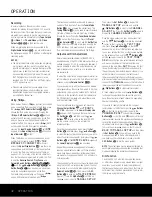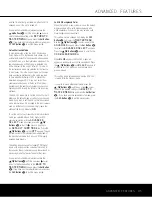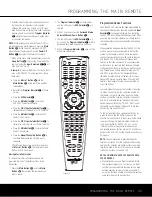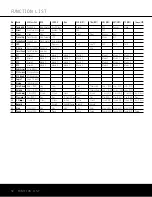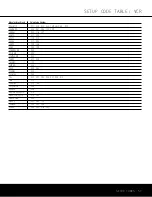
The AVR 340 is equipped with a number of advanced
features that add extra flexibility to the unit’s operation.
While it is not necessary to use these features to
operate the unit, they do provide additional options.
Figure 17
Front-Panel-Display Fade
In normal operation, the front-panel displays and indi-
cators remain on at full brightness, although you may
also dim them or turn them off using the
Dim Button
h
(see page 12). As an additional option, you may
also set the AVR so that the displays are on whenever
a button is pressed on the front panel or remote, but
then fade out after a set period of time.
To set the front-panel displays to the Fade mode,
press the
OSD Button
v
to bring the
MASTER
MENU
(Figure 1) to the screen. Press the
⁄
/
¤
Buttons
n
so that the
›
cursor is pointing to the
ADVANCED
line, and press the
Set Button
p
to enter the
ADVANCED SELECT
menu
(Figure 17).
With the
ADVANCED SELECT
menu on
your video display, press the
⁄
/
¤
Buttons
n
so
that the
›
cursor is pointing to the
VFD FADE
TIME OUT
line. Next, press the
‹
/
›
Buttons
o
so that the amount of time that you wish the dis-
plays to fade out after a button is pressed is shown.
Select
OFF
if you do not wish to have the front-
panel displays fade out.
Once this time is set and the unit returned to normal
operation, the displays will remain on for the time period
selected whenever a button is pressed on the front
panel or remote. After that time they will gradually fade
out, with the exception of the
Power Indicator
2
,
which will remain on to remind you that the AVR is
turned on. Note that if the displays have been turned
completely off using the
Dim Button
h
, the Fade
function will not operate.
If you wish to make adjustments to other items on
the
ADVANCED SELECT
menu, press the
⁄
/
¤
Buttons
n
to place the
›
cursor next to
the desired item, or place the
›
cursor next to the
BACK TO MASTER MENU
line and press
the
Set Button
p
to make an adjustment to another
menu. If you have completed all adjustments, press
the
OSD Button
v
to exit the menu system.
Turn-On Volume Level
As is the case with most audio/video receivers, when
the AVR 340 is turned on, it will always return to the
volume setting in effect when the unit was turned off.
However, you may prefer to always have the AVR 340
turn on at a specific setting, regardless of what was
last in use when the unit was turned off. To change
the default condition so that the same volume level
is always used at turn-on, you will need to make an
adjustment in the
ADVANCED SELECT
menu. To start the adjustment, press the
OSD Button
v
to bring the
MASTER MENU
(Figure 1)
to the screen. Press the
¤
Button
n
, until the on-
screen
›
cursor is next to the
ADVANCED
line.
Press the
Set Button
p
to enter the
ADVANCED
SELECT
menu (Figure 17).
At the
ADVANCED SELECT
menu make
certain that the on-screen
›
cursor is next to the
VOLUME DEFAULT
line by pressing the
⁄
/
¤
Buttons
n
as needed. Next, press the
›
Button
o
so that the word
ON
is shown in
the video display. Next, press the
¤
Button
n
once so that the on-screen
›
cursor is next to the
DEFAULT VOL SET
line. To set the desired
turn-on volume, press the
‹
/
›
Buttons
o
until the
desired volume level is shown on the
DEFAULT
VOL SET
line. This setting may NOT be made
with the regular volume controls.
NOTE:
Since the setting for the turn-on volume
cannot be heard while the setting is being made, you
may wish to determine the setting before making the
adjustment. To do this, listen to any source and adjust
the volume to the desired level using the regular
Volume Controls
Ò
b
. When the desired volume
level to be used at turn-on is reached, make a note of
the setting as it appears in the lower third of the video
screen or in the
Lower Display Line
ı
.
(
A typical
volume level will appear as a negative number such as
–25dB.) When making the adjustment, use the
‹
/
›
Buttons
o
to enter this setting.
The turn-on volume default will remain in effect until it
is changed or turned off in this menu, even when the
unit is turned off.
If you wish to make other adjustments, press the
⁄
/
¤
Buttons
n
until the on-screen
›
cursor
is next to the desired setting or the
BACK TO
MASTER MENU
line and press the
Set Button
p
. If you have no other adjustments to make, press
the
OSD Button
v
to exit the menu system.
Semi-OSD Settings
The semi-OSD system places one-line messages at
the lower third of the video display screen whenever
the Volume, Input Source, Surround Mode, tuner
frequency or any of the configuration settings are
changed. The semi-OSD system is helpful in that it
provides feedback on any control changes or remote
commands using the video display when it is difficult
to view the front-panel displays. However, you may
occasionally prefer to turn these displays off or adjust
the length of time the displays remain on the screen.
Both of those options are possible with the AVR 340.
This setting will also determine the length of time that
track identification and play time messages will appear
on your video display when The Bridge is in use.
To change the length of time that the semi-OSD
displays remain on the screen, or to turn them off, go to
the
ADVANCED SELECT
menu as outlined
earlier, and press the
⁄
/
¤
Buttons
n
as needed,
until the on-screen
›
cursor is next to the
SEMI
OSD TIME OUT
line. Next, press the
‹
/
›
Buttons
o
until the desired time in seconds or the
word
OFF
is displayed. This is a permanent setting
change, and the time-out entry will remain in effect
until it is changed, even when the unit is turned off.
If you wish to make other adjustments, press the
⁄
/
¤
Buttons
n
until the on-screen
›
cursor
is next to the desired setting or the
BACK TO
MASTER MENU
line and press the
Set Button
p
. If you have no other adjustments to make, press
the
OSD Button
v
to exit the menu system.
Full-OSD Time-Out Adjustment
The
FULL OSD
menu system is used to simplify
the setup and adjustment of the AVR 340, using a
series of on-screen menus. The factory default setting
for these menus leaves them on the screen for 20
seconds after a period of inactivity before they disap-
pear from the screen (Time-Out). Time-Out is a safety
measure to prevent image retention of the menu text
in your monitor or projector, which might happen if it
were left on indefinitely. However, some viewers may
prefer a slightly longer or shorter period before the
display disappears.
To change the full-OSD Time-Out, you will need
to make an adjustment in the
ADVANCED
SELECT
menu (Figure 17). To start the adjust-
ment, press the
OSD Button
v
to bring the
MASTER MENU
to the screen. Press the
¤
Button
n
, until the on-screen
›
cursor is next to
the
ADVANCED
line. Press the
Set Button
p
to enter the
ADVANCED
menu (Figure 17).
At the
ADVANCED SELECT
menu (Figure
17) make certain that the on-screen
›
cursor is next
to the
FULL OSD TIME OUT
line by press-
ing the
⁄
/
¤
Buttons
n
as needed. Next, press
the
‹
/
›
Buttons
o
until the desired time is dis-
played in seconds. This is a permanent setting change,
* ADVANCED SELECT *
VFD FADE TIME OUT:OFF
VOLUME DEFAULT:OFF
DEFAULT VOL SET:Ð25dB
SEMI OSD TIME OUT: 5S
FULL OSD TIME OUT:20S
DEFAULT SURR MODE:ON
OSD BACKGROUND:BLUE
B ACK TO MASTER MENU
44
ADVANCED FEATURES
ADVANCED FEATURES
AVR 340 OM 3/22/06 9:09 AM Page 44
Summary of Contents for AVR 340
Page 67: ......













